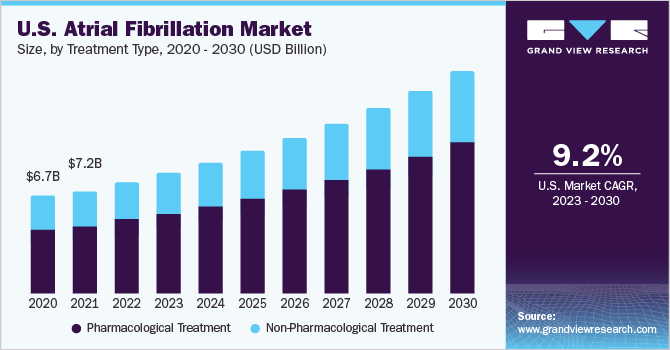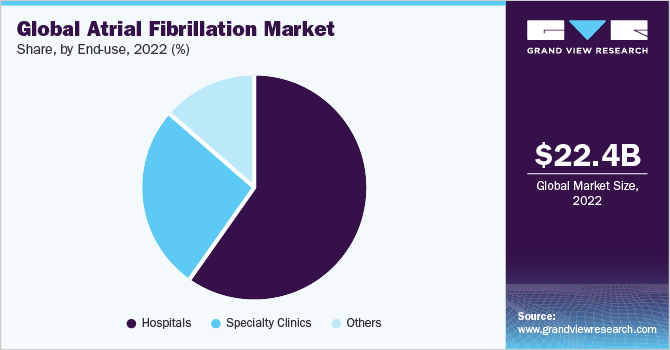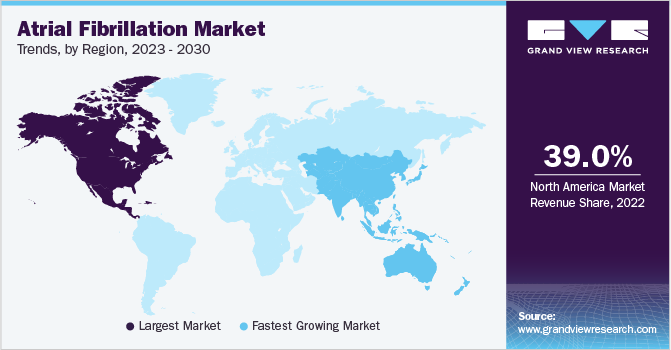- Home
- »
- Medical Devices
- »
-
Atrial Fibrillation Market Size & Share Analysis Report, 2030GVR Report cover
![Atrial Fibrillation Market Size, Share & Trends Report]()
Atrial Fibrillation Market Size, Share & Trends Analysis Report By Treatment Type (Pharmacological Treatment, Non-Pharmacological Treatment), By End-use (Hospital, Specialty Clinics), By Region, And Segment Forecasts, 2023 - 2030
- Report ID: 978-1-68038-004-0
- Number of Report Pages: 105
- Format: PDF, Horizon Databook
- Historical Range: 2018 - 2021
- Forecast Period: 2023 - 2030
- Industry: Healthcare
Atrial Fibrillation Market Size & Trends
The global atrial fibrillation market size was valued at USD 22.4 billion in 2022 and is projected to grow at a compound annual growth rate (CAGR) of 10.1% from 2023 to 2030. The increasing prevalence of atrial fibrillation (AFib) and growing awareness about the condition are expected to drive the market. Factors such as the aging population, lifestyle changes, and the surge in chronic illnesses such as obesity and diabetes are contributing to the rising incidence of atrial fibrillation. However, the market growth is hindered by the high costs associated with AFib procedures and devices. The COVID-19 pandemic has impacted the market by causing a decline in demand for AFib devices and procedures due to postponed non-urgent procedures. The pandemic has also led to shortages of certain medical devices and equipment due to disrupted global supply chains.

For instance, A study published in the National Library of Medicine found that cardiac surgeries in England have decreased by over 45,000 procedures during the pandemic without increasing the risk of mortality for most of these treatments. However, the pandemic has highlighted the importance of remote patient monitoring and telemedicine, which has increased during the pandemic and is expected to continue post-pandemic.
The increasing prevalence of atrial fibrillation and associated strokes is expected to drive market growth over the forecast period. In Asia, the number of atrial fibrillation cases is projected to reach 72 million by 2050, while in Europe, the number of people aged 55 and older with atrial fibrillation is expected to increase from 9 million in 2010 to 14 million by 2060. This rise in atrial fibrillation cases is driving the demand for treatments, including catheter ablation, anti-arrhythmic drugs, and non-pharmacological therapies.
Advancements in technology are transforming healthcare services and facilities for cardiovascular conditions. The rising prevalence of cardiovascular diseases is driving demand for advanced diagnostic and treatment devices that provide effective and efficient care. Key market players have successfully developed treatments for atrial fibrillation, such as in November 2021, Medtronic India launched its Arctic Front Cardiac Cryoablation Catheter System. This product targets pulmonary vein isolation to block unwanted electrical signals, enabling effective treatment of atrial fibrillation. These technological advancements and product launches are expected to fuel market growth.
Moreover, the introduction of new technologies and product approvals are increasing competition in the market. For instance, in August 2021, Abbott received the FDA's approval for its Amplatzer Amulet Left Atrial Appendage (LAA) Occluder. This product is designed to treat patients with AFib at risk of ischemic stroke, and its innovative design allows for immediately closing the LAA without the need for blood-thinning medication, effectively reducing the risk of stroke.
Treatment Type Insights
Based on treatment type, the AFib market is segmented into pharmacological and non-pharmacological treatment. The pharmacological treatment segment held the largest revenue share of over 65% of the atrial fibrillation market in 2022, due to the high demand for anticoagulant drugs and anti-arrhythmic drugs. Anticoagulant drugs held the largest share of this segment in 2022 due to these drugs are the most commonly prescribed medication for patients with atrial fibrillation. Anticoagulant drugs help prevent blood clots and reduce the risk of stroke, which is a common complication of atrial fibrillation.
The non-pharmacological segment is further segmented into catheter ablation, maze surgery, and electric cardioversion. The catheter ablation segment held the largest share of the market in 2022. Non-pharmacological techniques are becoming increasingly popular for treating atrial fibrillation and are considered the primary method for comprehensive arrhythmia management due to the limited antiarrhythmic and frequent proarrhythmic effects of drugs.
End-Use Insights
Based on end-use, the market has been further categorized into hospitals, specialty clinics, and others. The hospitals segment accounted for the largest share of the market in 2022, and it is estimated to register the fastest CAGR of 10.4% during the forecast period. The segment's rapid growth is primarily attributed to the high number of surgeries performed in hospitals, as well as the availability of skilled professionals and surgical equipment. Furthermore, the increasing prevalence of chronic disorders resulting in higher patient admissions is expected to drive the segment's growth over the forecast period.

The specialty clinics segment is also expected to gain significant growth over the forecast period owing to the increasing preference of individuals to undergo surgical interventions in specialty clinics. Moreover, the increasing prevalence of atrial fibrillation is driving demand for specialized care, and specialty clinics are well-positioned to meet this demand.
Regional Insights
The North American region is expected to dominate the market and held the largest revenue share of over 39% in 2022, owing to the increasing incidence of atrial fibrillation and a large patient population. The presence of major players in the region also contributes to this dominance. The CDC reports that in 2019, between 2.7 million and 6.1 million Americans had atrial fibrillation. By 2030, an estimated 12.1 million people in the United States will be affected by the condition. With the aging population, demand for AFib treatment is expected to increase in the coming years.

Asia Pacific is estimated to grow at the fastest rate during the forecast period. The growth is attributed to the increasing prevalence of cardiovascular diseases and atrial fibrillation in the region, coupled with investments in research and development to produce advanced cardiac care. Additionally, changing dietary habits and sedentary lifestyles are contributing to the rise in cardiovascular diseases and the demand for effective treatment options in the region.
Key Companies & Market Share Insights
Market players are introducing advanced products at affordable prices to increase their market share. Key players are implementing strategic initiatives, such as acquisitions, mergers, and collaborations, to maximize their market dominance. These players are expanding and diversifying their presence by developing new products and consolidating their position in the market to acquire a novel customer base.
For instance, in February 2023, Abbott received approval from both the European Union and the US FDA for its TactiFlex Ablation Catheter and Sensor Enabled products. These innovative ablation catheters feature a flexible tip and contact force sensing and are designed to treat abnormal heart rhythms, including atrial fibrillation. Additionally, the FlexAbility Ablation Catheter and Sensor Enabled also received expanded indications from the US FDA, making it suitable for treating patients with complex heart conditions. Some of the prominent key players in the global atrial fibrillation market include:
-
AtriCure Inc.
-
Boehringer Ingelheim GmbH
-
Boston Scientific Corporation
-
Bristol- Myers Squibb Corporation
-
Cardio Focus Inc.
-
Sanofi Aventis
-
Biosense Webster Inc.
-
Endoscopic Technologies Inc.
-
Abbott (St. Jude Medical Inc.)
-
Johnsons & Johnson
Atrial Fibrillation Market Report Scope
Report Attribute
Details
Market size value in 2023
USD 24.5 billion
Revenue forecast in 2030
USD 48.01 billion
Growth rate
CAGR of 10.1% from 2023 to 2030
Base year for estimation
2022
Historical data
2018 - 2021
Forecast period
2023 - 2030
Report updated
June 2023
Revenue in USD million and CAGR from 2023 to 2030
Report coverage
Revenue forecast, company ranking, competitive landscape, growth factors, and trends
Segments covered
Treatment type, end-use, region
Regional scope
North America; Europe; Asia Pacific; Latin America; Middle East & Africa
Country scope
U.S.; Canada; Germany; UK; France; Italy; Spain; Denmark; Sweden; Norway; China; Japan; India; South Korea; Australia; Thailand; Brazil; Mexico, Argentina; South Africa; Saudi Arabia, UAE; Kuwait
Key companies profiled
AtriCure Inc.; Boehringer Ingelheim GmbH; Boston Scientific Corporation; Bristol-Myers Squibb Corporation; Cardio Focus Inc.; Sanofi Aventis; Biosense Webster Inc.; Endoscopic Technologies Inc.; Abbott (St. Jude Medical Inc.); Johnsons & Johnson.
Customization scope
Free report customization (equivalent up to 8 analyst’s working days) with purchase. Addition or alteration to country, regional & segment scope.
Pricing and purchase options
Avail customized purchase options to meet your exact research needs. Explore purchase options
Global Atrial Fibrillation Market Report Segmentation
This report forecasts revenue growth and provides an analysis of the latest trends in each of the sub-segments from 2018 to 2030. For this report, Grand View Research has segmented the global atrial fibrillation market report based on treatment type, end-use, and region:
-
Treatment type Scope Outlook (Revenue, USD Million, 2018 - 2030)
-
Pharmacological Treatment
-
Anti-arrhythmic Drugs
-
Anticoagulant Drugs
-
-
Non-Pharmacological Treatment
-
Catheter Ablation
-
Radiofrequency
-
HIFU
-
Cryoablation
-
Microwave
-
Laser
-
-
Maze Surgery
-
Electric Cardioversion
-
-
-
End-Use Scope Outlook (Revenue, USD Million, 2018 - 2030)
-
Hospitals
-
Specialty Clinics
-
Others
-
-
Regional Scope Outlook (Revenue, USD Million, 2018 - 2030)
-
North America
-
U.S.
-
Canada
-
-
Europe
-
U.K.
-
Germany
-
France
-
Italy
-
Spain
-
Denmark
-
Sweden
-
Norway
-
-
Asia Pacific
-
Japan
-
China
-
India
-
South Korea
-
Australia
-
Thailand
-
-
Latin America
-
Brazil
-
Mexico
-
Argentina
-
-
Middle East & Africa
-
South Africa
-
Saudi Arabia
-
UAE
-
Kuwait
-
-
Frequently Asked Questions About This Report
b. The global atrial fibrillation market size was estimated at USD 22.4 billion in 2022 and is expected to reach USD 24.5 billion in 2023.
b. The global atrial fibrillation market is expected to grow at a compound annual growth rate of 10.1% from 2023 to 2030 to reach USD 48.01 billion by 2030.
b. North America dominated the atrial fibrillation market with a share of 39.75% in 2022. This is attributable to the presence of high procedure volumes supported by the presence of sophisticated healthcare infrastructure, high patient awareness, and healthcare expenditure levels.
b. Some key players operating in the atrial fibrillation market include AtriCure Inc., Boehringer Ingelheim GmbH, Boston Scientific Corporation, Bristol-Myers Squibb Corporation, Cardio Focus Inc., Sanofi Aventis, Biosense Webster Inc., Endoscopic Technologies Inc., Abbott (St. Jude Medical Inc.), and Johnson & Johnson.
b. Key factors that are driving the atrial fibrillation market growth include the growing need for minimally invasive procedures, the increasing prevalence of atrial fibrillation and associated strokes, smaller cardiac incisions, and faster post-surgical recovery times.
Share this report with your colleague or friend.
![gvr icn]()
NEED A CUSTOM REPORT?
We can customize every report - free of charge - including purchasing stand-alone sections or country-level reports, as well as offer affordable discounts for start-ups & universities. Contact us now
![Certified Icon]()
We are GDPR and CCPA compliant! Your transaction & personal information is safe and secure. For more details, please read our privacy policy.
We are committed towards customer satisfaction, and quality service.
"The quality of research they have done for us has been excellent."





